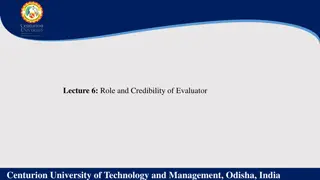Approaches for Impact Assessment at Centurion University, India
Various approaches for impact assessment include Experimental Design, Quasi-Experimental Design, Before-After Comparison, Counterfactual Analysis, Cost-Benefit Analysis, Qualitative Methods, and Mixed Methods. These methods help evaluate the effectiveness and efficiency of interventions by measuring their impact through different methodologies such as randomized controlled trials, comparison groups, and economic analysis. Centurion University of Technology and Management in Odisha, India, utilizes these approaches to assess the outcomes of their programs and interventions.
Download Presentation

Please find below an Image/Link to download the presentation.
The content on the website is provided AS IS for your information and personal use only. It may not be sold, licensed, or shared on other websites without obtaining consent from the author. Download presentation by click this link. If you encounter any issues during the download, it is possible that the publisher has removed the file from their server.
E N D
Presentation Transcript
Lecture 26 & 27: Approaches for Impact Assessment Centurion University of Technology and Management, Odisha, India
1. Experimental Design: This approach involves creating a control group and an intervention group to measure the impact of a specific intervention. Random assignment is often used to ensure that participants are allocated to the groups in a unbiased manner. The impact is then assessed by comparing the outcomes of the two groups. Randomized controlled trials (RCTs) are a well-known example of this approach. 2. Quasi-Experimental Design: In situations where random assignment is not feasible or ethical, quasi-experimental designs are used. This approach attempts to create a comparison group that is as similar as possible to the intervention group, but without random assignment. Various techniques such as matching, difference-in-differences, or regression analysis are employed to estimate the impact. Centurion University of Technology and Management, Odisha, India
3. Before-After Comparison: This approach involves comparing outcomes before and after the intervention or program implementation. It measures the change in outcomes over time and attributes the difference to the intervention. However, this approach does not account for other factors that may have influenced the outcomes, making it susceptible to biases. 4. Counterfactual Analysis: This approach aims to estimate what would have happened in the absence of the intervention by constructing a counterfactual scenario. It involves identifying a comparison group that is similar to the intervention group and using statistical methods to estimate the impact based on the observed differences. 5. Cost-Benefit Analysis: This approach assesses the economic impact of an intervention by comparing the costs incurred with the benefits gained. It involves quantifying both the costs and the benefits in monetary terms. Cost- benefit analysis helps decision-makers understand the value for money and prioritize interventions based on their efficiency. Centurion University of Technology and Management, Odisha, India
6. Qualitative Methods: Qualitative approaches focus on understanding the processes, mechanisms, and contextual factors that contribute to the observed outcomes. These methods often involve interviews, focus groups, case studies, and document analysis to gather rich and in-depth information. Qualitative methods provide insights into the underlying reasons for the impact observed. 7. Mixed Methods: This approach combines quantitative and qualitative methods to provide a more comprehensive understanding of the impact. It involves integrating data from different sources and analyzing them in a complementary manner. Mixed methods allow for a deeper exploration of complex phenomena and provide a more nuanced understanding of the impact. Centurion University of Technology and Management, Odisha, India























